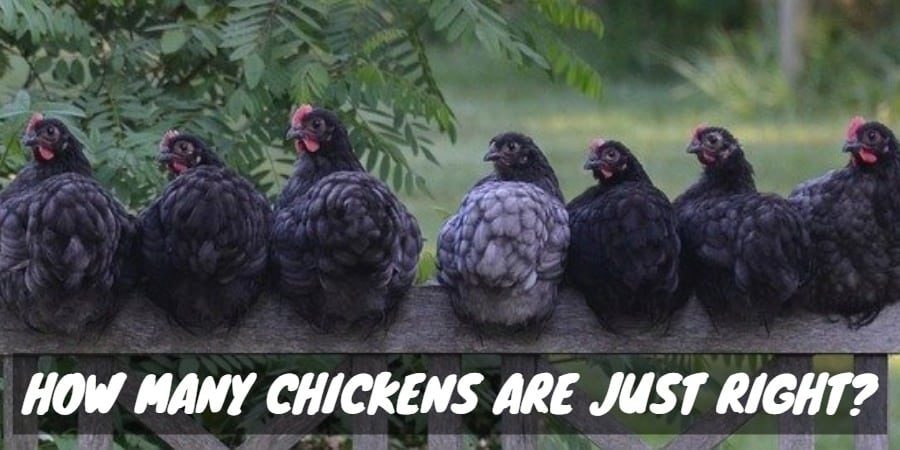Chickens are adorable and social creatures who do best in groupings no less than three.
But how many chickens is enough?
When I hear this question all I can think about is the Sugar Crisp cereal commercial from the 90’s … “You can never get enough!” But, is that true of these quirky and social creatures?

Before I dive into the realities of chicken math (because it is a thing) let’s discuss the primary considerations when it comes to determining the right number of birds for your flock.
How Many Chickens Should I Have?
I feel like I say this a lot but … it depends.
There are a few key things to consider when trying to determine the right size of flock for your family.
- Level of experience.
- Are you raising chickens for meat or eggs (or both).
- How big is your family.
- How much space do you have.
And lastly, are you prepared for chicken math?
Level of Experience
Many a backyard chicken tender has gone into the experience by diving into the deep end with disastrous results.
How much experience with chickens (including experience with specific breeds) is a big contributing factor when considering how many chickens is right for your flock.
Beginner Chicken Tenders
Start small.
A flock should contain no less than three birds. Four to six is a pretty good balance.
That is a pretty good place to start.
While you may be tempted to dive into the world of backyard chickens by getting yourself a bakers dozen, you don’t want to bite off more than you can chew.
Intermediate Chicken Keepers
As you gain experience with chickens you can readily increase the size of your flock, so long as you have adequate space.
A healthy backyard flock of 10 hens will supply you all the eggs you can use, even if you are a quiche and Dutch Baby fanatic.
You may even have eggs to spare!
Expert Chicken Whisperers
For all intents and purposes, as you gain experience you can readily add breeds and numbers to your flock, keeping in mind space requirements of your birds and temperaments.
Now, I will caveat that …
If you are a backyard chicken tender and you own hens for the purposes of feeding your family and maybe a few neighbours, there does come a point where you cross from chicken tender into crazy chicken person.

How Many Chickens for Meat or Eggs?
Aside from stunning pets that provide hours of entertainment and some solid pest control, chickens are kept for two reasons:
- meat
- eggs
The number of hens on your homestead, space not a factor, will be greatly impacted by what you plan on harvesting from them
How Many Chickens Do I Need for Eggs?
If you’re buying hens for their laying ability you are looking at an average output of 250-300 eggs per year (roughly one egg a day for most “layer” breeds – Rhode Island, Barred Rock, Rex or Black Sex Link etc).
Even a small flock of 3-6 birds will provide ample eggs for a family of four.
For example:
If you stock your coop with standard laying breeds, you can expect 5 eggs per bird, per week.
A small flock would yield, on average, 15-30 eggs per week (assuming 3-6 standard laying hens).
How Many Chickens Do I Need for Meat?
Before we dive into logistics, I want to tell you up front meat chicken are foul fowl.
They are stinky.
How many meat chickens you will want will depend on two main factors:
- How much chicken do you eat?
Keeping in mind that backyard chickens raised for meat tend to grow significantly larger than those in the super market, it’s reasonable to assume that the average family would consume 1 whole chicken every one to two weeks.
We are a large family (we have six children) and we eat an average of one free-range chicken per week in our regular cooking. Our hens are big and go a long way.
- How much space or time do you have?
Meat chickens do best in a chicken tractor that can be easily moved around (check out some of my favourite options at Omlet). Like I mentioned, meat birds are stinky and can quickly become a mess if not on a regular rotation of fresh grass.
Meat birds tend to grow quite quickly (reaching the age of processing as early as 8-10 weeks). This means that you can raise a few batches of meat birds in a year thereby reducing the space needed to house and move them.
How Many Chickens Do I Need for My Family?
As you start your journey into chicken tending you’ll want to evaluate what your egg consumption patterns are so that you can determine what a reasonable number of eggs to have on hand is.
Standard laying breeds can be expected to lay approximately 5 eggs per week, therefore, if you typically consume 12-18 eggs every week you’ll want at least 4-6 hens.
If you are too eager and you find yourself wth a flock laying more than you and your family can reasonably consume never fear! Backyard eggs almost never go to waste.
What Do I Do With Extra Eggs?
My friend, you will quickly learn that there is no such thing as extra eggs.
As soon as your friends and neighbours find out that you have farm fresh eggs you’ll have no shortage of options for gifting these ht commodities, or even selling them.
If you should find yourself with no such interest, you can always lime bath your eggs to preserve them for the winter months when your hens naturally slow down production, or take up more baking!
At the end of the day, you can always feed them back to your chickens (I do this often but always make sure to destroy the shells as to not promote egg eating from the nesting boxes).
How Many Chickens Can I Have in my Backyard?
Space is one of the primary limiting factors when deciding how many chickens to keep, both inside the coop and in their activity area.
The average chicken needs 2-3 square feet of coop space to allow for adequate movement and to prevent squabbles.
When it comes to outdoor space, while I would argue that free-ranging is the best option, it is not always practical or safe.
Chicken runs should provide an average of 5-10 square feet per bird.
As always, you will also want to check with your municipality or township by-laws as to how many chickens you are permitted to keep.

Always Account for Chicken Math
Alright chicken tenders, we need to be real here and we need to admit that chicken math is a thing.
Chickens come is a breathtaking array of colours, personalities, and quirky oddities.
Once you start learning about all the breeds, the colours of eggs, the eccentric nuances about chicken keeping, you’ll quickly realize that you want collect them all, like Pokemon.
Not to mention, when you hit up your local feed store and it’s chick day there is no way you’re leaving without at least half a dozen fluff balls.
As you look to start your chicken tending journey, always plan to expand your flock faster than you first anticipated, leave some space for the impulse chicken purchases.
Conclusion: How Many Chickens DO I Need?
While there are many contributing factors when it comes to determining your ideal flock size, the main consideration is space and consumption.
A small flock of 3-6 hens is great for a smaller family of 2-4 people who eat eggs occasionally.
Remember, if you find yourself in a chicken math situation and you have a flock that produces more eggs than you could consume even as the most avid baker, there are always people who prefer, and appreciate, the beauty and health benefits of farm fresh eggs.
So, with chickens, the Sugar Crisp quote, “You can never get enough,” rings pretty true.




